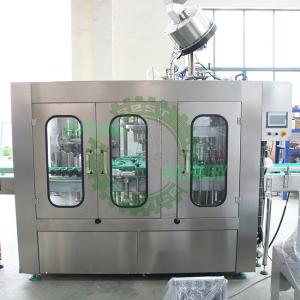Description of Integrated Glass bottle balanced pressure carbonated drink filling line
Carbonated beverage blending system---carbonated beverage is mainly composed of water, syrup, and carbon dioxide. The syrup is made through the sugar pot and blending tank, and filtered and pumped into the syrup tank in the carbonated beverage mixer. At the same time, the sterilized product water It is also pumped into the water tank in the beverage mixer and degassed to facilitate the mixing of carbon dioxide. Through the proportioning system on the beverage mixer, the water and syrup are mixed in proportion to achieve the desired taste, and the mixed materials are passed through The plate heat exchanger is used for cooling, where the other end of the plate heat exchanger is mainly connected to a chiller (providing cold water, adding antifreeze, and the outlet temperature is about -3°C). Through this heat exchange method, the material can be cooled When the temperature reaches 0℃~3℃, feed the material into the carbon dioxide mixing tank in the beverage mixer, and under the control of proper pressure, make the carbon dioxide fully dissolve into the material to make a carbonated beverage.
Carbonated beverage filling and packaging system---the material mixed with carbon dioxide is directly injected into the liquid cylinder of the carbonated beverage filling machine through the pipeline, and the equal pressure filling principle is used for fixed liquid level filling. In the carbonated beverage production line, the bottle enters the carbonated beverage filling machine (commonly known as the three-in-one equal pressure filling machine in the industry) by the air duct and the bottle mouth under the action of wind, and the bottles are washed, filled and capped in sequence. The capped semi-finished products are output by the conveyor belt, and then undergo light inspection (artificial visual inspection of the presence of impurities in the bottle, and a good quality line of defense), a bottle warming machine (used to raise the temperature of the material in the bottle from 3°C to room temperature, otherwise it will be heated After the air, the bottle wall will produce a lot of dew, which will wet the packaging box after packaging), blow dryer (used to dry the water on the bottle), inkjet printer (used to mark the production date), labeling machine (divided) For sleeve labeling and labeling, depending on the bottle), packaging machine (divided into film wrapping machine and carton packaging machine, depending on the actual situation).
Filling part:
The principle of equal pressure filling is adopted, and the filling valve adopts a mechanical valve. The filling speed is fast and the liquid level accuracy is high. It has a perfect CIP cleaning function. The combination of a guide device at the filling valve port and a lifting device at the bottom of the supporting bottle makes the bottle mouth and the filling valve accurately sealed, reducing the phenomenon of material leakage from the tank mouth; accurately filling beer, sparkling wine, and sparkling beverages, with No bottle breakage, no dripping, convenient operation and maintenance, etc.
Capping part:
The capping part seals the cap on the can of the filled product, and sends it to the subsequent process by the conveyor chain.
Based on the crown caps and aluminum caps provided by the customer, the sealing head is made of high-hardness alloy steel, which has a long service life and reduces cap damage.
Electrical apparatus of 4000BPH 3 in 1 18-18-6 Carbonated soft drink filling and packing line:
| Transducer | FuLing-Taiwan |
| Touch screen | Easyview-TaiWan |
| PLC | Mitsubishi |
| Stabilized voltage supply | MingWei-TaiWan |
| Contactor | Omron |
| Approach switch | Autonics |
| Air switch | Omron |
Parameters of 4000BPH 3 in 1 18-18-6 Carbonated soft drink filling and packing line:
| Model | DCGF18-18-6G |
| Capacity(B/H)(500ml) | 40000BPH(500ml) |
| Bottle size | Neck:φ20-50mm;Height:150-320mm |
| Water pressure | 0.18-0.25Mpa |
| Water consumption(kg/h) | 1000 |
| Filling precision | <+0.5MM |
| Air pressure | 0.4Mpa |
| Air consumption (m³/min) | 0.3 |
| Power(kw) | 4 |


